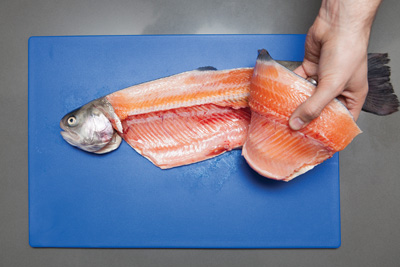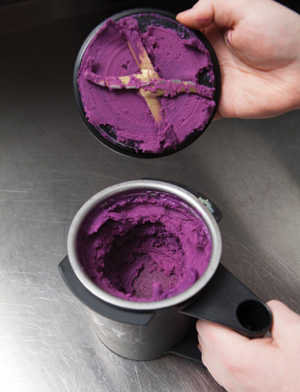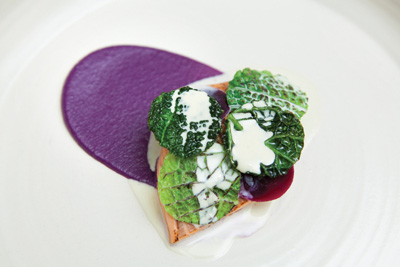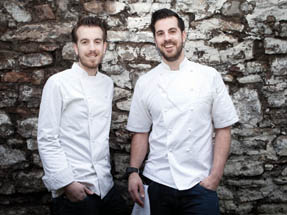Masterclass: Rainbow trout at Casamia
This seasonal favourite is combined with intense flavours of cabbage and cumin at Peter and Jonray Sanchez-Iglesias' Michelin-starred Casamia in Bristol. Michael Raffael reports.
As with all aquaculture, there's a wide range of quality. Trout is often sold as a single portion whole fish at about five months old. At the other end of the scale, the 1.2kg-plus fish reared with low stocking densities that minimise stress may be two years old. The 5kg monsters, the "truite de Banka" farmed in the Basque country, enjoy a five-year lifecycle. The quality of the feed and the flow of fresh water also influence the texture.
The brothers Sanchez-Iglesias reserve trout for their seasonal winter menus, but it isn't tied to a November-March window. However, during a winter such as this one, when the day-boats can't go out and supply fresh seafish consistently, it's a smart call.
Planning
Casamia prepares nine trout per batch to last over two lunch and two dinner services.
- Three days ahead of service, pickle the discs of red cabbage.
- One or two days ahead, prepare, cook and blend the red cabbage for the purée; freeze in Pacojet canisters.
- Fillet, skin and salt the trout. Portion ahead of service.
- Prepare the Savoy cabbage discs and dehydrate.
- Infuse the cream sauce; pulse and strain ahead of service.
- Finalise to order. Oil-poach the fillets and smoke with a flame-gun. Reheat the red cabbage purée. Plate with the cabbages and sauce.
Yield and cost
A 1.25kg trout (gutted weight) will yield about 50% edible meat. At Casamia, after filleting, trimming and cutting into approximately 70g portions (tasting menu serving), it will yield six pavés.
A large, gutted rainbow trout from supplier Mere Fish Farm (www.merefishfarm.co.uk) costs about £8 per kilo. After filleting and heavy trimming, the portions cost about £20 per kilo and the yield is 12 portions.
The dish 'rainbow trout, variations of cabbage, cumin' appears on the £68, 10-course menu and aims for a 70% gross profit.
Preparing the fillets
This is similar to the classic method for gutted round fish. The aim is to finish with perfect, sushi-like flesh that can be portioned into pavés. Work with a very sharp, fish-filleting knife.
On either side of the head, behind the gills and pectoral fins, cut through to the backbone. Cut off the head.
When taking the top fillet off the bone, never saw. Lay the fish on the board with the back facing you.
Remove the top fillet in two cuts. Keeping the blade against the backbone, pull it from head to tail in a single cut.
Lift the flesh and make a second cut that separates the fillet from the backbone.
Turn the fish over and repeat.
Trimming and skinning
The belly flap is covered in an outer stomach lining. Keeping the blade under it (there are still long rib bones attached) and remove this in one piece (3).
Remove the ridge and fin along the edge of the back. The anal fin also needs trimming.
To skin the fillets, start with a cut across the tail-end down to the skin. Hold the skin and tail-end in one hand. Lay the knife against the skin with the blade almost flat.
Jiggle the skin from side to side and pull it towards you to separate it from the flesh in a single piece.
Pinbone and trim the edges of the fillet to obtain a lean fillet weighing between 220g and 300g.
Salting
This isn't so much a curing process as a means of firming the fillet and absorbing excess moisture.
Place a sheet of clingfilm over a chopping board. Sprinkle 25g Maldon salt in a strip and lay the fillet on it. Cover with a second 25g layer of salt. Wrap the fillet up tightly in the film and leave for about five minutes. Unwrap, wipe off the salt, and pat dry.
Divide the fillet into three neat portions weighing about 80g each. Set aside until ready to serve.
Red cabbage puree
Casamia makes a batch size based on three Pacojet canisters, yielding 100-120 servings. It can be scaled up or down working with the same proportions.
Ingredients
1kg chopped red cabbage
500g butter
900ml red cabbage juice (extracted using a commercial juicer)
140ml cider vinegar
Salt
Sweat the red cabbage in butter until it starts to wilt and soften. Add the juice, boil and simmer for 10 minutes. Add the vinegar and blend in a food processor. Add salt to taste. Transfer to Pacojet canisters and freeze.
Pickled red cabbage discs
Red cabbages and their leaves vary in size. Stamp out discs from the outer leaves with a 4cm cutter, two per portion.
Ingredients
450ml red cabbage juice (extracted using a commercial juicer)
15g Maldon salt
15g sugar
10g toasted cumin seeds
80ml cider vinegar
Up to 100 red cabbage discs
Boil the juice, seasonings and cider vinegar. Add as many discs as the pickle will hold. Simmer for one hour at 98°C.
Transfer to a kilner jar or similar. Leave to stand uncovered in the kitchen for three days until the cabbage begins to ferment slightly (9).
Cumin creamBatch size at Casamia is based on 2.25 litres of double cream (the photograph shows 250ml of cream).
(Serves 6)
1 large Savoy cabbage leaf
15g finely diced shallot
1 level tsp toasted cumin seeds
½ small bay leaf
Maldon salt
Lay the cabbage leaf flat on the work surface. Use a blowtorch to char the ribs (the leaf should not be completely burnt) (10). Shred it roughly.
Bring the cream to the boil in a small pan.
Add the leaf and the other ingredients. Simmer for a minute.
Take the pan off the heat and leave the cream to infuse for 30 minutes.
Using a hand blender, pulse the cream to distribute more flavour through it. Don't blend the sauce or it will discolour. Pass though a fine chinois or muslin.
Refrigerate and store ahead of service.
Toasted Savoy cabbage crisps
The dark green outer leaves of Savoy cabbage are ideal. Stamp out discs with a 4cm cutter, two per portion.
Lay the leaves flat on the work surface. Cut out as many discs as necessary for a service. Preheat a deep fryer to 160°C. Fry the leaves a few at a time for 30 seconds precisely. Drain them and pat dry.
Preheat the dehydrator to 65°C. Dry the leaves for 2-3 hours or until crisp. Store in a sealed container.
RAINBOW TROUT, VARIATIONS OF CABBAGE, CUMIN
The fish is poached in pomace oil, which is warmed in a water bath.
(Serves 1) Pomace oil for poaching (2.25 litres per service,
ie, about 30 portions)
1 x 80g prepared trout fillet
40g (2 servings) red cabbage purée
2 pickled red cabbage discs
2 Savoy cabbage crisps
40-50ml hot cumin cream
Heat the oil to 54°C. Poach the fillet in the oil for 10 minutes. Drain and pat dry. Lay the fish on the work surface with the cut surface uppermost. Blowtorch the surface so it has a dark mahogany, almost smoky appearance.
Reheat the red cabbage purée. It's impractical to work with any smaller quantity unless using a microwave.
Spread about 20g of the purée on a hot plate. Lay the fillet of trout on it. Add the pickled red cabbage and cabbage crisps. Finish with the cumin cream.
Tips
When skinning the trout, a silvery finish on the surface of the flesh is a sign of freshness.
To grip the tail end when skinning, dip your fingers in a little salt.
When preparing several fish, pack them together between layers of salt, as smoked salmon curers do. It saves time and money.
PETER AND JONRAY SANCHEZ-IGLESIAS
It's a very European mix, Casamia. The restaurant at Westbury-on-Trym, a Bristol suburb, sounds Italian; the two brothers, Jonray and
Peter, are pure English West Country, and the family name, Sanchez-Iglesias, is Spanish - their father came from Seville.
Jonray and Peter, the two chef-patrons, are very driven. They've developed a formidable reputation since winning a Michelin star in 2009 and, probably more valuably from a commercial standpoint, topped the bill on the Channel 4 series Ramsay's Best Restaurant.
But this summary only tells part of the story of the brothers who work together without any obvious friction. "We're on the same level," says Peter, the older. "Each of us knows what the other is trying to achieve."
They had just returned from a trip to restaurant El Celler de Can Roca in Spain, awarded best restaurant in the world in 2013, when they tackled the Caterer and Hotelkeeper Masterclass. The brothers recognised the supreme quality of the fish dishes at El Celler, but they were level-headed enough to notice the odd glitch.
Jonray and Peter's goal is to create a complete restaurant that works in every detail. For example, they change the artwork in the dining room to match the changing seasonal menus, they commission a local potter to provide bespoke flatware, and they use their test kitchen on the first floor to trial and retest recipes.
Reflecting on their ambition to keep on improving, Peter is blunt: "I want everything to be perfect. If you start in the s* you finish in the s*." Many chefs will be able to relate to his point of view.














